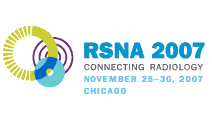
Abstract Archives of the RSNA, 2007
Grady Wilson Miller PhD, Presenter: Research support, Siemens AG
Ugur Bozlar MD, Abstract Co-Author: Nothing to Disclose
Jaime F. Mata PhD, Abstract Co-Author: Nothing to Disclose
John P. Mugler PhD, Abstract Co-Author: Research grant, Siemens AG
Research Consultant, Siemens AG
Gordon D. Cates PhD, Abstract Co-Author: Nothing to Disclose
Klaus D. Hagspiel MD, Abstract Co-Author: Nothing to Disclose
To demonstrate that oxygen-weighted ³He lung MRI is sensitive to regional variations in ventilation-perfusion ratio (V/Q), and compare two pulse sequences for mapping alveolar oxygen partial pressure (pO2).
V-Q mismatch was created in five anesthetized rabbits using a model of reversible pulmonary embolism. Under fluoroscopic guidance, a balloon angiocatheter was inserted through the right femoral vein and placed in the left pulmonary artery. Upon inflation, the balloon obstructed perfusion to the lower lobes of the left lung. Two different ³He MR pulse sequences were used to generate 2D maps of alveolar pO2. In method 1, the phase encoding order was arranged to minimize contamination of the pO2 measurement by RF-coil inhomogeneity, while method 2 relied on additional RF excitations to explicitly measure and correct for such effects. Coronal pO2 maps (32x64 matrix, 4mm resolution) were obtained in each rabbit with the balloon inflated and deflated. Each scan was performed during a 6-sec forced breath hold, following inhalation of 30ml of ~35% polarized ³He. Mean and standard deviation of pO2 pixel values were computed separately for each lung using automated analysis code.
Regional pO2 elevation was conspicuous in the lower left lung on pO2 maps obtained with the balloon inflated. Lesions resolved upon deflation. During inflation, mean measured pO2 differences between R and L lungs were 40 mmHg for method 1 and 29 mmHg for method 2. This contrast was highly significant (p<.001 for both methods). With the balloon deflated, L-R differences dropped to 9 mmHg (p=.05) and 0 mmHg (p=.97), respectively, suggesting a baseline bias in method 1. Measurement noise was 17% higher using method 2, with weak significance (p=.26).
Oxygen-weighted ³He lung MRI is sensitive to regional V-Q mismatch. Elevated pO2 values were consistent with impaired gas exchange due to reduced perfusion. Although one pulse sequence yielded higher contrast-to-noise ratio, further study is required to determine if this apparent advantage is offset by baseline bias.
Oxygen-weighted ³He lung MRI is sensitive to regionally elevated V/Q resulting from obstructed pulmonary perfusion.
Miller, G,
Bozlar, U,
Mata, J,
Mugler, J,
Cates, G,
Hagspiel, K,
Lung pO2 Mapping with Hyperpolarized ³He MRI in an Animal Model of Regional V-Q Inequality. Radiological Society of North America 2007 Scientific Assembly and Annual Meeting, November 25 - November 30, 2007 ,Chicago IL.
http://archive.rsna.org/2007/5010615.html

